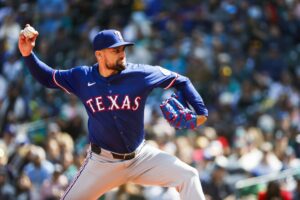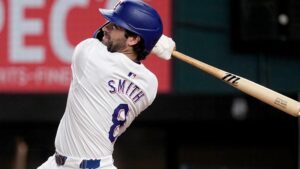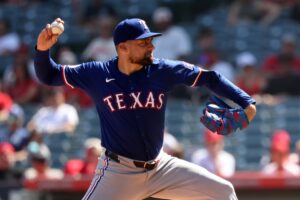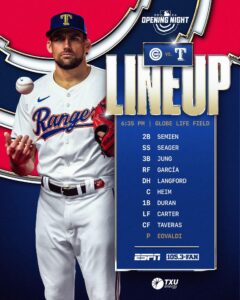It seems interesting that all last year we heard that the Rangers were going to need pitching this year. Specifically they would need starters because they started this year with only Cole Hamels and Martin Perez under contract. John Daniels chose to go the cheap route by acquiring Mike Minor, Doug Fister, and Matt Moore to the rotation for about $23 million this year. That is about the same price that it would have cost to bring Jake Arrieta or resign Yu Darvish respectively.
That hasn’t worked out the way Daniels thought it would. Matt Moore is in the bullpen, Doug Fister is on the DL, and Mike Minor is much better with 7-8 days’ rest. The team instead brought in the oldest player in baseball Bartolo Colon, and he has been entertaining and very good in spots. They also had to bring up the veteran Yovani Gallardo, who can at least fill some innings. Martin Perez’s busted elbow in the offseason made things even worse.
The tragedy with all bad baseball teams is that when they do get a solid performance from the pitching staff, the bats go silent. Most disappointing is Cole Hamels performance has dropped significantly. I will add the team does have the worst defense in the league, which means that hurts any pitcher. That is not really a complete excuse for Hamels or any other pitcher, but it does factor in to a league worst ERA, as it probably adds a half to one run to the ERA total.
My assessment of the pitching staff currently is that they have four guys who might be a #5 starter on a few teams, and 1 who might be a #3 but probably a #4. It is hard to win with that type of pitching staff.
However, that is not the whole story with this team. Yes, it is exciting seeing the younger players develop. The hard part is watching them being forced to grow up here instead of at AAA, as they should be. The Rangers are going to have some tough decisions as the trade deadline approaches with an eye toward the future.
Start with Joey Gallo, who has a decent on base percentage and according to the “new baseball” math, which is supposed to be good. However, the Rangers as a team are first in the league in strikeouts, and Joey Gallo leads the Rangers. I agree a strikeout is not the worst outcome of an at bat, especially with runners on base. What the math doesn’t say is that the ability to move the runner along is far more important. Gallo swings for the home run with every pitch. His stance only handles that, and he has zero ability to hit the ball to the opposite field. Gallo probably needs better coaching on a fundamental approach to the plate that he is never going to get with the Rangers.
Roughned Odor shows flashes of brilliance followed by complete ineptitude. He is the epitome of all that has happened to the team this season. High on a cloud, or completely in the tank, with more time in the tank and complete lack of consistency are the hallmark of the 2018 team and Odor. Delino DeShields finishes the first half in a 0-28 slump, with a single time on base in that stretch. The question is how much patience does the organization have with these three. At some point they must improve or be replaced.
There are bright spots, Nomar Mazara is having a very nice year, Isaiah Kiner-Falefa has been a pleasant surprise and can play anywhere in the field you need him too. Heck I say let him pitch, he couldn’t be much worse. Ronald Guzman looks like the real deal too; he hits to all fields, does amazing splits to all the bad balls thrown to first, and has a little pop to his bat. Jurickson Profar has done well at the plate, but sometimes when he throws the ball only God above knows where it is going.
The bottom line is there are some pieces for the future of this franchise going forward that are fun to watch.
As the trade deadline approaches, the thing Rangers fans need to keep in mind is that a team has to want what you have to sell. As of today, there are two players on the team that fit that bill. Keona Kela who has been tremendous as closer, and he has several controllable years left on his contract. He will have seriously high demand, and he is probably the best pitcher on the team for what he does. The other is Jake Diekman, because a left-handed pitcher who can get outs is also in high demand, especially relief help for the playoffs.
There is buzz about trading Cole Hamels but frankly, nobody wants $23 million in salary and a #4 starter. Sin Soo-Choo would help many playoff teams, but nobody is going to want his $23 million salary either. Elvis Andrus is coming off an injury, but it costs a ton to get him. Adrian Beltre would help some teams but his hamstrings are a liability no playoff team wants to bank on.
The Rangers could make some trades to try to dump salary but frankly, that doesn’t even make sense at this point. The bottom line is that the team can trade some highly valuable bullpen pieces, which is something every team loves to bolster for a playoff run, but beyond that, there is not a lot that anyone else wants because there is other better players for less money available somewhere else.
If I were John Daniels, and it is probably a good thing I am not, because I would have signed both Yu Darvish and Jake Arrieta this offseason and spent $50 million more on pitching, I would not trade anyone now. Instead, I would wait for the offseason and try to put together some deals. That allows some of the players to improve the second half of the season and I might even decide some of them need to stay. What it doesn’t solve is the current starting rotation issues.
What many Rangers fans don’t know is that farm system has been ravaged by injuries. This is a short recap of some of the top pitching prospects:
1. Cole Ragans—Tommy John
2. Kyle Cody—Tommy John
3. Yohander Mendez—Sent to all the way down to Class A from the Rangers and AAA due to professional concerns
4. Joe Palumbo—Tommy John, ETA was 2018 for the majors
5. Ariel Jurado no ability to get batters to swing and miss
6. C.D. Pelham relegated to bullpen
7. Michael Matuella huge health concerns
8. Ricardo Rodriguez on and off DL, strictly a reliever
9. Clayton Blackburn–Tommy John, acquired in trade and should have been major league ready this season
10. Ronald Herrera–torn tendon flexor, should have been major league ready this season
11. Alex Speas–Tommy John
There are currently six of the 11 out with arm problems that have had Tommy John surgery or are about to have it. I did not add Chi Chi Gonzales to the list who had surgery last season and is in rehab now. The deal with young players having these types of arm problems is that nobody knows if they will make it back or not. They were not fully developed, so it will mean starting over for all of them.
Think about those numbers for a minute. Six of eleven possible future starters out with reconstructive surgery, one has huge health concerns, two are now bullpen guys, one can’t get anyone out, and another was sent from the Rangers all the way back to class A ball. IF, and it is a big IF, any of these guys return it will take a year to recover from the surgery, and another year to regain form. That means the earliest any of these guys can impact the team is 2021 as rookies. The odds are not good for any of them ever pitching in the majors, period.
The organization does have other pitchers in the pipeline, but there is nothing at AAA that will be ready next season and nothing to get excited about at AA Frisco. The reality yet again is that the earliest someone might accelerate through from Class A to the big leagues is 3-4 years. That means 2021-2022 before we see those rookies in Arlington.
This is why I would have spent $50 million this offseason to try to bridge the gap. Then again, John Daniels thinks pitchers are fragile and does not believe in investing money in them. He is partially correct. However, when you have a workhorse like a Nolan Ryan running the organization things are different because the expectation is that the pitchers should be able to do what those of his generation did. Now it is all about analytics, and baseball math and what the computer projects.
The Rangers do have some nice pieces for the future, they have a mix of some veterans to lead, and they have a great clubhouse. What they don’t have is pitching and everyone knows, even without a computer, that you cannot win without solid pitching. As long as the team fields, four fives and a three, this team will dwell in the cellar.
The Rangers would like to be sellers; they need to acquire young pitching prospects. They just do not have the assets to trade, unless you want to trade Nomar Mazara, and a few others who are showing they really are the future of this team. I believe Daniels will make some moves, but don’t expect anything earth shattering in return. The Rangers just do not have very much that another team needs for a playoff run. That is why I think the organization is better off holding on to their young players, and riding out the veteran contracts at least until the offseason. They can find more value at the winter meetings than they will now.
What the Rangers will also get next year is a top 10-draft pick. Patience is the key to rebuilding, but this situation goes much deeper. Trades to acquire talent at the trade deadline of past seasons are one issue, but the bigger issue is the massive injury train plaguing their farm system pitching. This is a trend in baseball as players throw harder and harder seemingly every season. Baseball has gone all in on the home run, and hard throwing pitchers. The Rangers today have become victims of that approach. Until the team, returns to traditional fundamentals of baseball there will never be consistency. That means getting on base, moving runners along, pitching to contact, and playing good defense.
A team is never going to win by leading the universe in strikeouts. They cannot win without solid pitching. Those are the fundamental issues for the Rangers regardless of talent. It appears to me that is coaching, and organizational philosophy rather than talent. Getting two runners on base and hitting the home run sounds great, until there are three consecutive strikeouts. Leading the league in stranded runners is another stat that is a result of this philosophy.
The bottom line is the organization needs significant change to return to fundamentals at all levels. That means pitchers learning to pitch and not throw. Batters learning to hit the ball where it is pitched and learning situational hitting, while reducing strikeouts are the fundamentals that must be taught at all levels. Rebuilding the farm system will take time, and a few years of losing to get better prospects. The Rangers are just not going to be a contending team for at least three years, and probably longer. In the meantime, enjoy watching the kids develop, look for the little things like hitting the ball to the opposite field, and celebrate when a player does something right.
This is the state of the team today with a view to the future. The variables that can change things are eating salary for big payroll players to gain prospects and signing free agents next season. Otherwise, it is a long rebuilding process to get back to being relevant.




